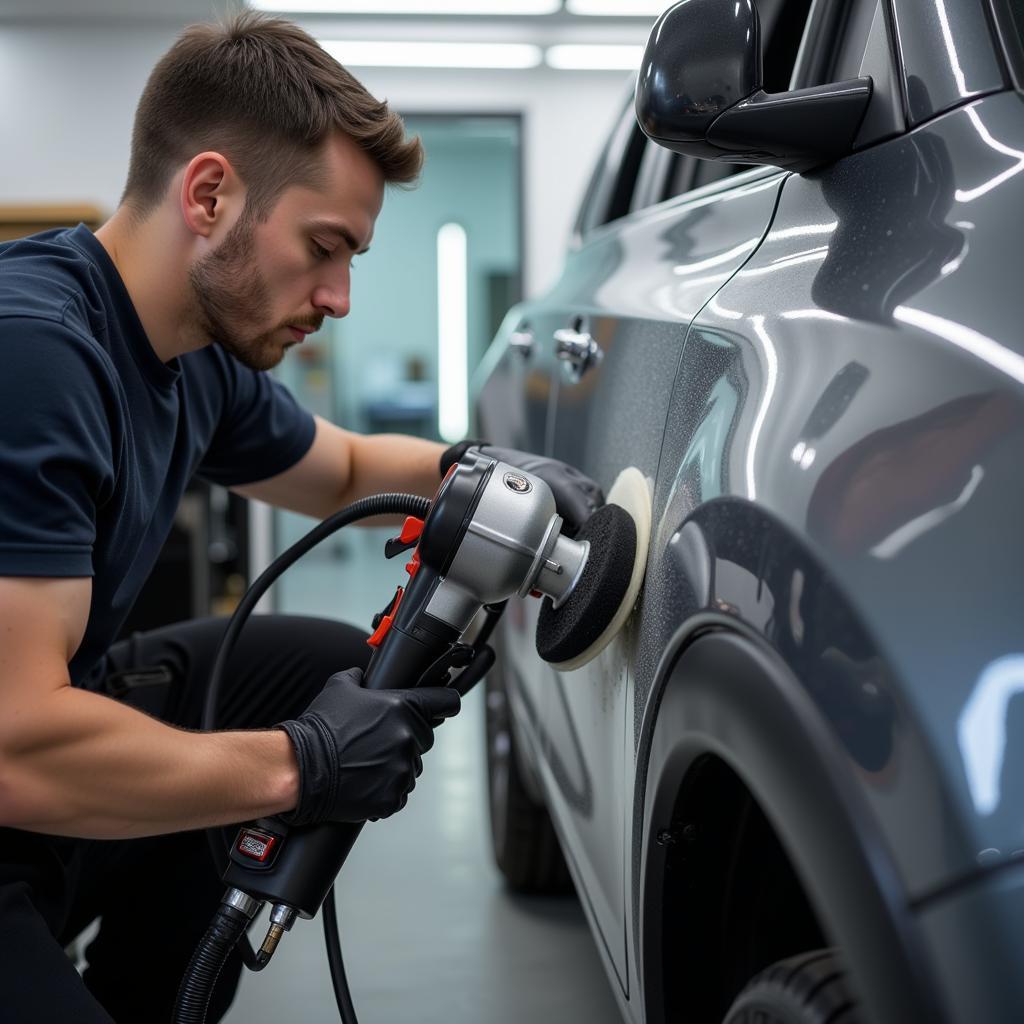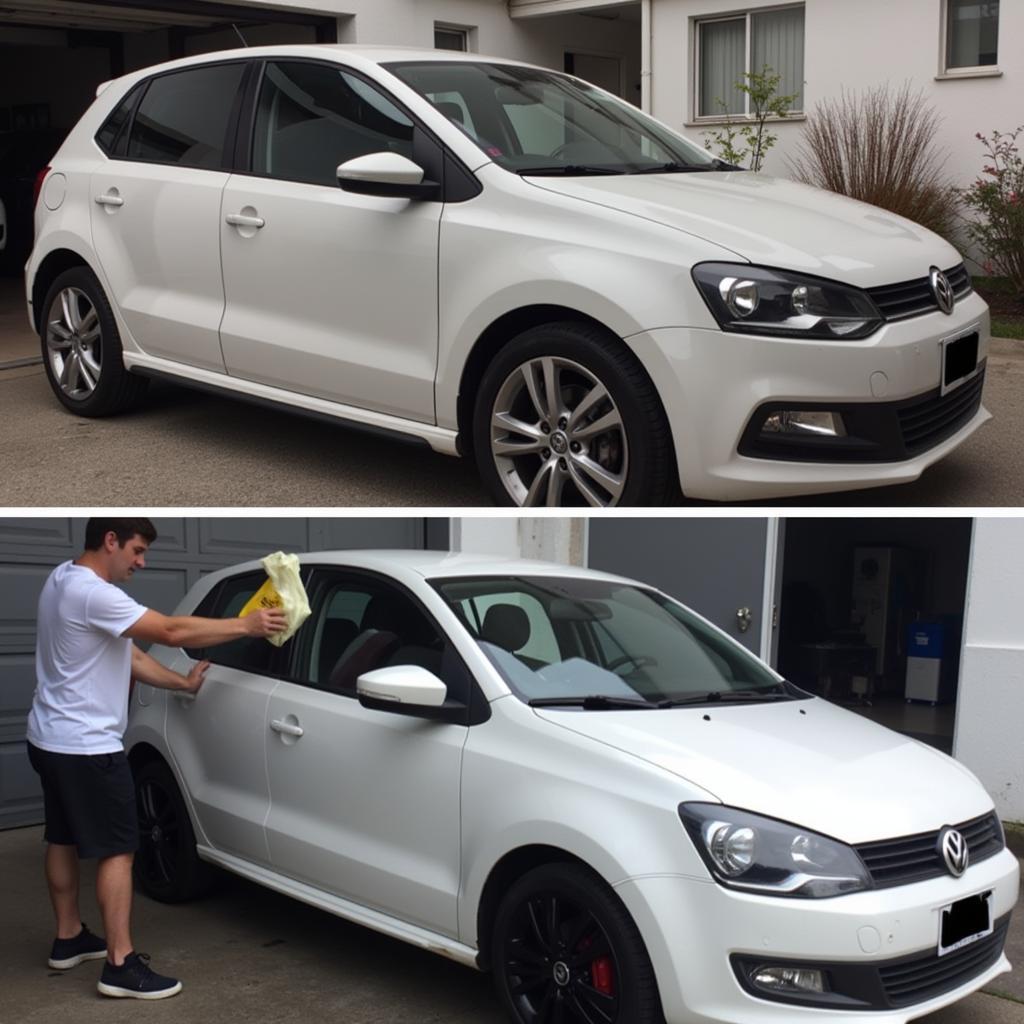Does Car Detailing Make Paint Like New? It’s a question many car owners ask, hoping to restore their vehicle’s finish to its former glory. While detailing can significantly improve a car’s appearance, achieving a truly “like-new” paint job often depends on the current condition of the paint and the techniques employed. Let’s dive into the world of car detailing and explore the possibilities.
A professional detailer can work wonders on a car’s finish, removing swirl marks, light scratches, and environmental contaminants that dull the paint. Detailing goes beyond a simple car wash, employing specialized tools and techniques to rejuvenate the exterior and interior. However, deep scratches, chips, or significant oxidation may require more extensive work, such as paint correction or even a full respray, to achieve a truly “like-new” result. Understanding the difference between detailing and paint correction is crucial to setting realistic expectations. Detailing focuses on enhancing the existing paintwork, while paint correction aims to remove imperfections in the clear coat and restore the original paint color.
How Car Detailing Improves Paint
Car detailing involves a multi-stage process that can dramatically improve the appearance of your car’s paint. It starts with a thorough wash and decontamination to remove loose dirt, grime, and bonded contaminants. This is often followed by clay bar treatment to remove embedded particles that washing alone can’t tackle. Next, a polishing stage using specialized compounds and machines can reduce swirl marks and minor scratches, restoring shine and clarity. Finally, a sealant or wax is applied to protect the paint and enhance its gloss.
For more detailed information on how to properly price your car detailing services, check out our article: how should i price my car detailing business.
Does Detailing Remove Scratches?
While car detailing can minimize the appearance of minor scratches and swirl marks, it doesn’t completely remove deep scratches that have penetrated the clear coat or the paint itself. Think of it like polishing a slightly scratched piece of furniture – it improves the overall look but doesn’t magically erase the deep gouges. For those deeper imperfections, paint correction is usually necessary.
The Difference Between Detailing and Paint Correction
Understanding the distinction between detailing and paint correction is key. Detailing enhances the existing paintwork through cleaning, polishing, and protecting. Paint correction, however, involves more aggressive techniques like wet sanding and compounding to level the clear coat and remove deeper imperfections. Paint correction can achieve a truly “like-new” finish but is more complex, time-consuming, and costly than detailing.
“Think of detailing as a facial for your car,” says renowned detailing expert, John Peterson, “while paint correction is more like cosmetic surgery.” Peterson emphasizes the importance of understanding the level of work required to achieve desired results, as client expectations often vary.
 Car Paint Correction Process
Car Paint Correction Process
The Limits of Car Detailing
While car detailing can dramatically improve a car’s appearance, it’s not a miracle cure. It can’t fix chipped paint, deep scratches, or severe oxidation. In those cases, a respray or touch-up paint may be the only solution. Also, detailing doesn’t address underlying issues with the paint, such as fading due to sun exposure.
Wondering if detailing can handle more unusual cleaning challenges? See our article: can a full detail car wash clean poop.
Maintaining a Detailed Finish
Once your car has been detailed, proper maintenance can prolong the results. Regular washing, using high-quality car shampoo, and applying a sealant or wax every few months can help protect the paint and maintain its shine. Avoiding automated car washes and using microfiber cloths for drying can also prevent swirl marks and scratches. It’s about preserving the investment you’ve made in your car’s appearance.
“Regular maintenance is crucial for keeping your car looking its best,” advises detailing specialist, Sarah Miller. “A little effort can go a long way in preserving the results of a professional detail.”
 Maintaining Car Paint After Detailing
Maintaining Car Paint After Detailing
Car detailing can significantly enhance your car’s paint, making it look significantly better. While it might not always make it “like new” in every scenario, particularly with severe damage, it’s a valuable investment for restoring and maintaining your car’s appearance. Knowing what to expect from detailing and when paint correction is necessary is key to achieving your desired results.
FAQ
- How often should I detail my car? It depends on your driving conditions and how meticulous you are about maintenance, but generally, every 6-12 months is recommended.
- Can I detail my car myself? Yes, with the right tools and techniques, but professional detailers have the expertise and equipment to achieve superior results.
- How much does car detailing cost? Prices vary depending on the services included and the detailer’s experience.
- What’s the difference between waxing and sealing? Both protect the paint, but sealants typically offer longer-lasting protection.
- Does car detailing remove water spots? It can remove many water spots, especially those caused by minerals.
Curious about who typically gets their cars detailed? Check out this article: what type of people get their cars detailed. Also, if you’re thinking about tipping your detailer, do you tip people who detail your car offers some helpful insights.
If you need any assistance, feel free to contact us via WhatsApp: +1(641)206-8880, or Email: [email protected]. Our customer support team is available 24/7.

Leave a Reply